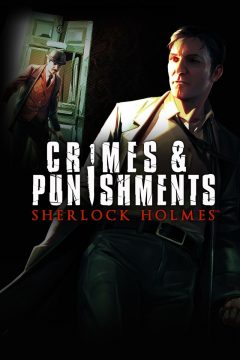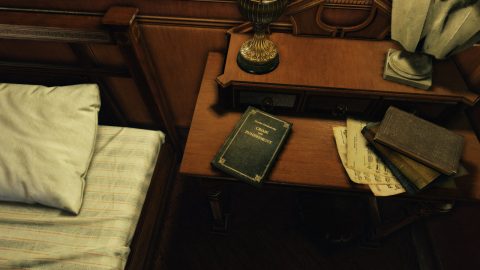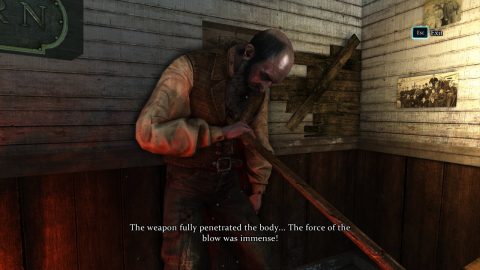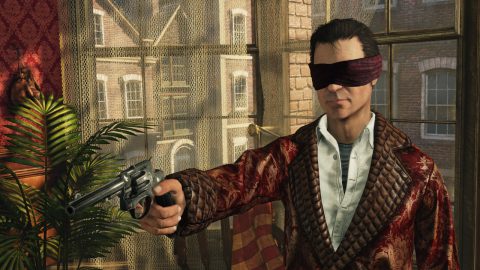- Sherlock Holmes: The Mystery of the Mummy
- Sherlock Holmes: Secret of the Silver Earring
- Sherlock Holmes: The Awakened (2006)
- Sherlock Holmes: Nemesis
- Frogwares’ Sherlock Holmes Casual Games
- Sherlock Holmes Versus Jack the Ripper
- Testament of Sherlock Holmes, The
- Sherlock Holmes: Crimes & Punishments
- Sherlock Holmes: The Devil’s Daughter
- Sherlock Holmes: Chapter One
- Sherlock Holmes: The Awakened (2023)

Sherlock Holmes: Crimes & Punishments starts with Doctor John Watson’s reading Crime and Punishment by Fyodor Dostoevsky, a famous piece of Russian literature about a young man who justifies a murder of an evil person with his nihilist beliefs, but finds that view tested when that murder also results in him killing an innocent person. He is interrupted by Holmes practicing blindfold shooting in the next room (he’s bored so it’s fine). It is not long before they have a new case, one which ends with Holmes having to decide if the true criminal should be condemned to their fate at the hands of the law, or given a more lenient sentence by Holmes’ own doing.

Up until now, these Frogwares games have been graded on a sort of curve, comparing the games to each other. Realistically, their fairly average scores fit them pretty well. There’s a lot to love about these games made by a plucky middle market team, but none of them have had the level of polish or the wow factor of the classics of the genre.
Crimes & Punishments is different. It isn’t just great for this series, it’s great, period. It deserves to be considered a genuine modern classic of the adventure game genre. The game even influenced Francisco Gonzales’ Lamplight City, as confirmed on Twitter. This is the real deal, and proof that Frogwares is more than capable of delivering something unique, memorable, and above all, just good as all get out at what it does.

The script is whip smart and surprisingly mature, even with its regular swerves into wacky Sherlock goofs and gabs (one involving bees). A major reason for this is the team ditching the one big case structure of previous games and making an episodic series of adventures that have mention of a background story to wrap up the game later. That story revolves around a group of supposed revolutionaries calling themselves the Merry Men, but Sherlock Holmes refuses to be strong armed into finding them for his brother and instead focuses on a series of six cases instead as they come to him.
The connective tissue here is entirely thematic. Each case is unique from most Sherlock Holmes stories, tossing out black and white heroes and villains for the complex realities on judging the severity of someone else’s crimes and how they should be punished, if at all. The new morality choice system in place is one of the rare good examples of such a system in games, making you seriously consider the situation placed at you to judge, and obfuscating a scant few details every time to make the decision all the more difficult.
What really makes this work is that background story with Sherlock’ brother Mycroft and the Merry Men perfectly mirrors the ongoing conflict of each case. No matter how different they are, every scenario deals with the conflict of order and freedom, the necessity of the law and questioning how to counteract the injustices it creates. Bad actors take advantage of broken systems constantly, and good people find themselves in grim and desperate situations.
The obfuscated details mentioned earlier is the full intent of the actions of every true killer, which is what the moral choices focus on. How you approach them depends on how you interpret the situation and why they did what they did, or even what parts of the case they’re responsible for. The idea was so well realized here that both Devil’s Daughter and Chapter One would reuse the system wholesale.
Crime and Punishment doesn’t just pop up at the start of the game either. Sherlock reads it during some loading screens, and it becomes a topic of discussion between the characters at the end of the game. That’s clearly on purpose. Every case in this game mirrors the core philosophical conflict that the main character of the book, Rodion, deals with. Both examine how we can justify horrible acts as a method of justice against clear evil, and how easily that can spiral out of control or be influenced by our lesser qualities. For the book, the lead is clouded by his egotism, viewing his actions as justified for freeing himself and others to allow for great deeds to be done.
The game doesn’t come to one side of the argument or the other (though there seems to be a lot of seething contempt for Sherlock’s brother Mycroft), instead setting up a scenario where you’re allowed to come to your own answer and further define it with how you decide how each case ends. A lot of these are genuine tests of your own morality, thinking through carefully the complexities of every situation and what the best option is. Do you trust the system to do what it says its supposed to do, or take things into your own hands and give someone a chance to change with a more lenient fate? Is that person deserving of harsh judgment or a chance to live a better life?
…this series had a subplot about underground turtle race betting just three games ago. How things change.
All of this is great, but what really makes it work is the new open case structure. The deduction board has been modified to be inside Holmes’ mind palace, and while the game never uses that word (the term used properly in Chapter One, hilariously), it’s certainly taking inspiration from the aesthetics of the BBC’s Sherlock series. It’s most obvious in forming profiles, which has you picking up on small details to form an idea of who this suspect is and various details about them usually missed. The aesthetic touch that makes it pop are the borrowed use of floating, shifting words to represent shifting thought, even using the same sound stings.
For the deduction board, you can put together two clues or observations you found and made, which can potentially create a thought. This thought can combine with others as you go, creating a theory. These theories can be wrong, the correct one usually requiring a complete collection of every clue on the case. So, you’d probably just ignore deductions until you get a smoking gun clue, but it also ties into case progression.
There’s a new task list that grows as you find new leads, and you can create leads in your mind palace. Observations forming into a thought can lead into a new angle to explore, leading to recreations of proposed events, new factions to look into, and questions to consider. It’s a brilliant addition to the game where thinking carefully over what you’ve seen and heard can reveal new layers to the case not immediately apparent.
Adding to all of this is a great deal of streamlining. Inventory puzzles are as simple as find item and then use it with a prompt, no need for an inventory screen. Puzzles are even more simple than before, still with some solid brain teasers here and there, but not to the point they can distract from the case. The task list keeps you on track to leads to follow, allowing open ended exploration without making things aimless. It’s simply enjoyable to go from detail to detail, task to task, the case showing more and more then you could have first expected.
It also looks incredible. Tons of extremely detailed areas litter the place, with better performance than Testament with a change over to Unreal Engine 3. There’s nicer, natural lighting and shadows, resulting in a world that feel a bit more real than before, relying less on color and more on natural shades and a sense of lived in weariness. The character models also look much better, one upping Testament with more considered character animations during dialog for you to read into. Sherlock’s egotistical smile is a particular highlight.
Alongside great voice acting, much more serious than previous, there’s a scant use of music. There is a score that does pop up, but much of gameplay is just ambient noise of the world around you, from the passing wind to insects in the distance. It helps you get absorbed into the moment and keep focused on the task at hand. The other new touches are filters for certain modes, like using the returning Toby having a fuzz to make smells easier to follow. They’re mainly here for a more focused vision Sherlock can use to see details others would miss, a more limited detective vision, and an imagination mode for reconstructing possible events based on gathered evidence.
All of this is extremely well considered and adds something to the game that creates a whole and unique package. You can’t mistake this game for anything else, not even in its own franchise. Crimes & Punishments does everything it needs to do and then some, making it one of the most gripping entries while dialing back on set-pieces, outside the odd QTE moments at the end of some cases. It is lean, mean, and one of the most memorable works of adventure gaming of the past decade. If you haven’t played it yet, don’t sleep on it. Helps the game is almost entirely standalone, making it a good entry spot into the greater franchise.
With all this success, it’s no surprise the next game would borrow the structure of this entry wholesale. What is a surprise is that Frogwares would slap this structure into a game based around action set-pieces inspired by Hollywood blockbusters. The end result was a bit messy.


